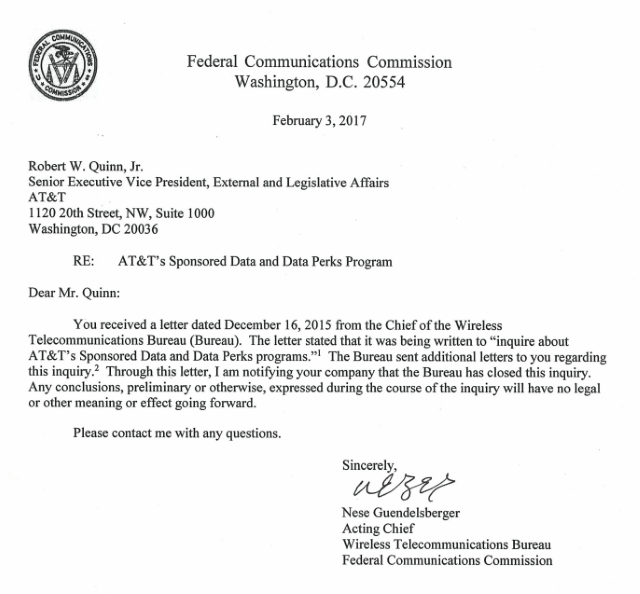 New York State taxpayers will contribute $212 million to expand broadband to reach 89,514 homes and institutions in mostly in rural upstate communities that either lack internet access or have to endure very slow speed DSL service from the phone company. All recipients have agreed, as a condition of receiving the money, not to impose data caps on their customers.
New York State taxpayers will contribute $212 million to expand broadband to reach 89,514 homes and institutions in mostly in rural upstate communities that either lack internet access or have to endure very slow speed DSL service from the phone company. All recipients have agreed, as a condition of receiving the money, not to impose data caps on their customers.
This week, New York Governor Andrew M. Cuomo announced the latest winning projects that will receive grants from a second round of funding from the New NY Broadband Program, part of the governor’s effort to achieve 100% broadband penetration in the Empire State.
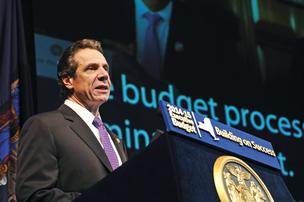
Gov. Cuomo
Twenty six cable and phone companies, mostly for-profit businesses, will share awards ranging from $226,184 for Cable Communications of Willsboro to reach 558 homes in the Essex County communities of Willsboro and Essex, on the border of Lake Champlain and the state of Vermont to $47,770,970 for Armstrong Telecommunications to reach 16,545 homes in Allegany, Cattaraugus, Erie, Livingston, Steuben, and Wyoming counties in the Finger Lakes Region and Southern Tier.
“Broadband is today what electricity was nearly a century ago – essential to creating economic opportunity, driving innovation and an absolute necessity for our way of life,” Governor Cuomo said. “These awards will provide homes and businesses with access to the high-speed internet required to participate and succeed in the modern economy, and are a major step toward broadband for all in New York.”
Grant recipients provided $56,253,037 in private matching funds, with New York taxpayers picking up the remaining 75% of the total expansion cost — about $2,366 per home or business.
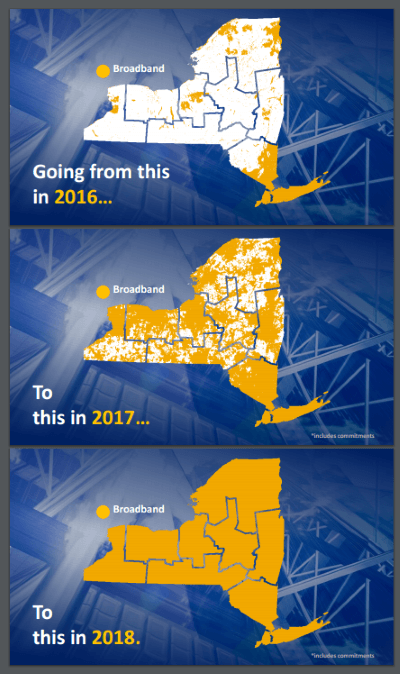 A separate agreement with the New York State Public Service Commission obligates Charter Communications (formerly Time Warner Cable) to embark on its own company-funded expansion program to expand service to approximately 145,000 unserved and underserved premises. Charter has identified Columbia, Erie, Jefferson, Onondaga, Oswego, and Sullivan as “Year One Priority Counties” where most upgrades will be taking place in 2017, including expansion to reach 100Mbps speeds during the first six months of this year.
A separate agreement with the New York State Public Service Commission obligates Charter Communications (formerly Time Warner Cable) to embark on its own company-funded expansion program to expand service to approximately 145,000 unserved and underserved premises. Charter has identified Columbia, Erie, Jefferson, Onondaga, Oswego, and Sullivan as “Year One Priority Counties” where most upgrades will be taking place in 2017, including expansion to reach 100Mbps speeds during the first six months of this year.
The winning providers had to guarantee they would upgrade speeds to at least 100Mbps except in the “most remote areas” where 25Mbps is acceptable. Although the state targeted 50% private sector co-investment, providers ultimately came closer to the absolute minimum of 20% in matching funds. They must also guarantee that broadband service will be available to customers for no more than $60 a month to qualify for the grant. Cable Communications of Willsboro, for example, now offers 8/1Mbps for $59.95 a month. Presumably it will have to boost speeds as part of its grant award.
The grant program was also designed to favor applicants offering fiber-to-the-home or hybrid fiber/cable (HFC) technology currently favored by cable operators. DSL and fixed wireless applicants had to give evidence the governor’s need for speed would be delivered using those technologies. All applicants must also agree not to impose data caps of any kind for New York residents.
New York is a rare exception to rural broadband expansion in states that mostly rely on politicians begging and pleading with providers to expand their service areas. At best, this has delivered modest results without access to supplemental funding to achieve Return On Investment requirements private companies demand.
As New York progresses through multiple rounds of bidding, each new round becomes more challenging because of the increasing expense to reach each remaining unwired rural home, business, and farm. In the current round, the costs to wire a single home are at least four times more than what Verizon spent to extend its FiOS service to a new home or business in downstate New York.
To meet 100% penetration, some properties will require a $20,000 or more investment to extend service. Gov. Cuomo has decided that broadband should be treated as a necessary utility, not a convenience. In effect, New York wants universal service standards to be applied to broadband, regardless of cost.
All projects must be finished by the end of 2018. The Broadband Program Office is currently finalizing a Request for Proposals for the Program’s upcoming Round III, which will launch within 30 days. This round will seek to complete the goal of bringing high-speed internet access to New York’s remaining unserved and underserved communities. Round III will be paid for by the $170 million in Connect America Funds Verizon forfeit because of their lack of interest in expanding rural broadband service. New York officials successfully petitioned the Federal Communications Commission to reallocate those funds to the state to disburse to reach the remaining rural areas still without suitable internet access.
Phase 2 Awardees
| Awardee | Projects | Census Blocks | Total Units | State Grant Total | Private Match | Total Project Cost |
|---|---|---|---|---|---|---|
| TOTALS |
54
|
10,378
|
89,514
|
$211,798,593
|
$56,253,037
|
$268,051,631
|
| Altice | 1 | 25 | 346 | $867,281 | $216,821 | $1,084,102 |
| Armstrong Telecommunications | 4 | 1,678 | 16,545 | $47,770,970 | $12,472,577 | $60,243,547 |
| Cable Communications of Willsboro | 1 | 11 | 558 | $226,184 | $56,546 | $282,730 |
| Castle Cable TV Television, Inc. | 1 | 14 | 129 | $632,559 | $158,140 | $790,699 |
| Champlain Telephone Company | 1 | 58 | 334 | $1,362,901 | $340,726 | $1,703,627 |
| Chazy and Westport Telephone Corporation | 2 | 222 | 530 | $2,821,185 | $705,297 | $3,526,482 |
| Citizens of Hammond | 1 | 40 | 382 | $1,395,688 | $348,923 | $1,744,611 |
| Delhi Telephone Company | 1 | 284 | 818 | $3,392,373 | $848,094 | $4,240,467 |
| DFT Local Service Corporation | 1 | 212 | 973 | $4,274,536 | $1,068,634 | $5,343,170 |
| DTC Cable Inc. | 1 | 413 | 1,524 | $4,432,209 | $1,899,518 | $6,331,727 |
| Empire Telephone Corporation | 3 | 277 | 1,692 | $3,236,891 | $809,226 | $4,046,117 |
| Fairpoint | 3 | 2,015 | 10,321 | $36,668,472 | $9,301,930 | $45,970,402 |
| Frontier Communications | 11 | 1,189 | 12,003 | $29,901,354 | $7,475,354 | $37,376,708 |
| Gtel Teleconnections | 2 | 442 | 2,450 | $5,259,217 | $1,314,806 | $6,574,023 |
| Haefele TV Inc. | 2 | 386 | 3,407 | $5,022,332 | $1,255,751 | $6,278,083 |
| Mid-Hudson Data Corp. | 1 | 449 | 18,771 | $849,818 | $212,455 | $1,062,273 |
| Middleburgh Telephone Company (MIDTEL) | 1 | 228 | 1,599 | $6,831,856 | $1,707,964 | $8,539,820 |
| Mohawk Networks, LLC | 1 | 754 | 3,623 | $6,391,157 | $1,597,792 | $7,988,949 |
| MTC Cable | 4 | 183 | 2,982 | $6,529,775 | $2,391,035 | $8,920,810 |
| New Visions Communications | 1 | 266 | 3,906 | $11,310,921 | $2,827,731 | $14,138,652 |
| Newport Telephone Company | 1 | 255 | 1,919 | $9,348,940 | $2,337,237 | $11,686,177 |
| Oneida County Rural Telephone | 1 | 210 | 588 | $3,285,885 | $821,474 | $4,107,359 |
| Otsego Electric Cooperative | 2 | 122 | 714 | $3,935,949 | $1,145,065 | $5,081,014 |
| Pattersonville Telephone Company | 1 | 93 | 170 | $1,188,748 | $297,187 | $1,485,936 |
| Slic Network Solutions | 2 | 121 | 891 | $3,746,744 | $937,871 | $4,684,615 |
| TDS Telecom | 4 | 431 | 2,339 | $11,114,648 | $3,704,883 | $14,819,531 |
Interested in Learning If Broadband is Expanding in Your Area? A complete list of community expansion projects follows:


 Subscribe
Subscribe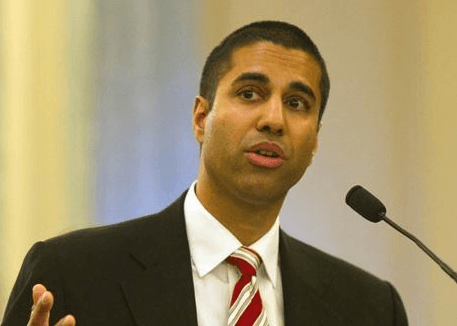
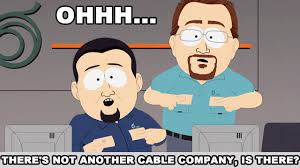 The FCC order approving the merger deal was hardly onerous, requiring Charter to compete head-to-head for customers in places the company can choose itself. Lawmakers eliminated exclusive cable franchise agreements years ago, but established major cable operators like Charter have gone out of their way to avoid competing in areas that already receive cable service. While Wheeler may have hoped some of that competition would be directed against fellow cable companies, Charter CEO Thomas Rutledge quickly made clear to investors and the FCC Charter would continue to avoid direct cable competition, instead promising to expand service into non-cable areas that already get DSL service from the phone company or no broadband at all.
The FCC order approving the merger deal was hardly onerous, requiring Charter to compete head-to-head for customers in places the company can choose itself. Lawmakers eliminated exclusive cable franchise agreements years ago, but established major cable operators like Charter have gone out of their way to avoid competing in areas that already receive cable service. While Wheeler may have hoped some of that competition would be directed against fellow cable companies, Charter CEO Thomas Rutledge quickly made clear to investors and the FCC Charter would continue to avoid direct cable competition, instead promising to expand service into non-cable areas that already get DSL service from the phone company or no broadband at all.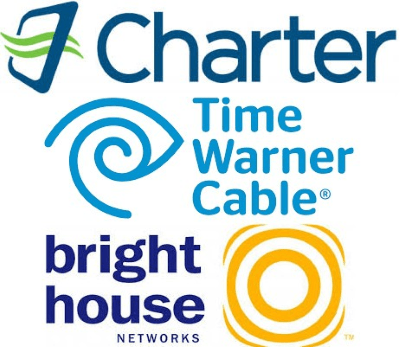 Rutledge’s clear views about Charter’s expansion plans apparently never made it to the American Cable Association, a cable industry lobbying group that defends the interests of independent and smaller cable operators. Despite Rutledge’s public statements, the ACA and its members are afraid Charter could expand on their turf anyway, potentially forcing small cable operators to compete with the same level of service Charter offers. The horror.
Rutledge’s clear views about Charter’s expansion plans apparently never made it to the American Cable Association, a cable industry lobbying group that defends the interests of independent and smaller cable operators. Despite Rutledge’s public statements, the ACA and its members are afraid Charter could expand on their turf anyway, potentially forcing small cable operators to compete with the same level of service Charter offers. The horror. The real goal here is to minimize direct competition at all costs. The FCC’s deal conditions already included the need for more rural broadband expansion. Wheeler’s second goal was to introduce a new model — cable company competing against cable company — fighting for new customers by offering consumers better service and pricing. The existence of such competition would belie the industry’s claim that cable overbuilds and head-to-head competition is uneconomical. Wildly profitable, perhaps not, but certainly possible. Historically, the traditional way cable operators dealt with the few instances of direct cable competition was to buy them out to put them out of business. Rutledge was certainly thinking along those lines when he complained that the FCC’s order to compete did not include permission to eventually devour its competitor, effectively making competition go away.
The real goal here is to minimize direct competition at all costs. The FCC’s deal conditions already included the need for more rural broadband expansion. Wheeler’s second goal was to introduce a new model — cable company competing against cable company — fighting for new customers by offering consumers better service and pricing. The existence of such competition would belie the industry’s claim that cable overbuilds and head-to-head competition is uneconomical. Wildly profitable, perhaps not, but certainly possible. Historically, the traditional way cable operators dealt with the few instances of direct cable competition was to buy them out to put them out of business. Rutledge was certainly thinking along those lines when he complained that the FCC’s order to compete did not include permission to eventually devour its competitor, effectively making competition go away.
 The average Charter/Spectrum customer shares their internet connection with up to 499 of their neighbors, according to an admission made today by Charter Communications CEO Thomas Rutledge.
The average Charter/Spectrum customer shares their internet connection with up to 499 of their neighbors, according to an admission made today by Charter Communications CEO Thomas Rutledge.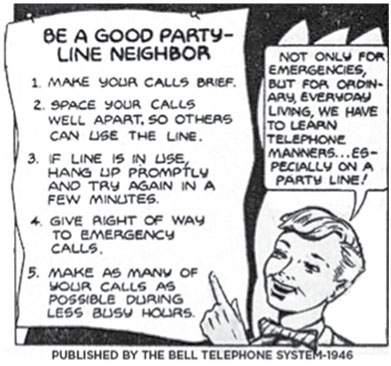 Rutledge’s comments this morning suggest Charter/Spectrum customers may be sharing their connection with up to 499 of their neighbors, making them more likely to experience congestion potentially worse than experienced with Time Warner Cable. Standard internet service from Charter is also much faster than Time Warner Cable’s corresponding Standard plan — 60Mbps vs. 15Mbps, which has the potential to lead to even worse slowdowns if customers use their internet connections at the same time.
Rutledge’s comments this morning suggest Charter/Spectrum customers may be sharing their connection with up to 499 of their neighbors, making them more likely to experience congestion potentially worse than experienced with Time Warner Cable. Standard internet service from Charter is also much faster than Time Warner Cable’s corresponding Standard plan — 60Mbps vs. 15Mbps, which has the potential to lead to even worse slowdowns if customers use their internet connections at the same time.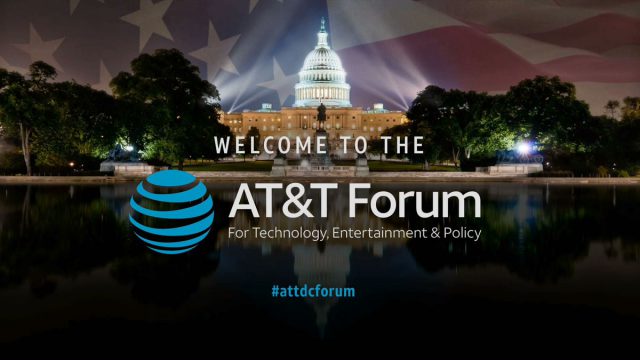 As your AT&T wireless bill soars to new heights, the phone company is spent your money on an exclusive inside-the-beltway private soirée to help win approval of its merger deal with Time Warner, Inc.
As your AT&T wireless bill soars to new heights, the phone company is spent your money on an exclusive inside-the-beltway private soirée to help win approval of its merger deal with Time Warner, Inc.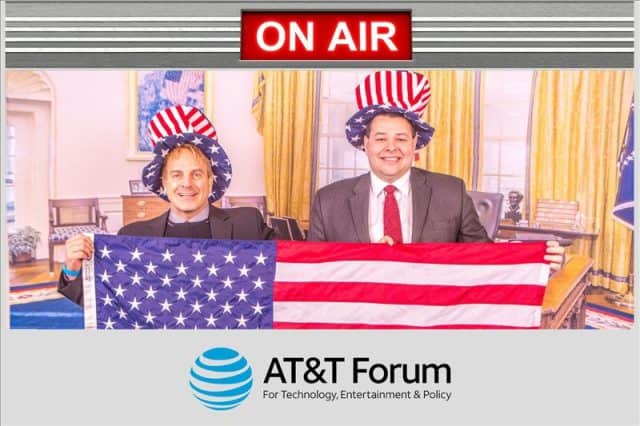


 Announced the formation of a Broadband Deployment Advisory Committee that is expected to be stacked with industry stakeholders that will recommend reform the FCC’s pole attachment rules, identify “unreasonable” regulatory barriers to broadband deployment, encourage local governments to adopt “deployment-friendly” policies, and develop a “model code” for local franchising, zoning, permitting, and rights-of-way regulations for telecom infrastructure like cell towers. Few expect the eventual “model code” to stray far from Big Telecom companies’ wish lists;
Announced the formation of a Broadband Deployment Advisory Committee that is expected to be stacked with industry stakeholders that will recommend reform the FCC’s pole attachment rules, identify “unreasonable” regulatory barriers to broadband deployment, encourage local governments to adopt “deployment-friendly” policies, and develop a “model code” for local franchising, zoning, permitting, and rights-of-way regulations for telecom infrastructure like cell towers. Few expect the eventual “model code” to stray far from Big Telecom companies’ wish lists;